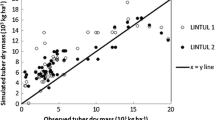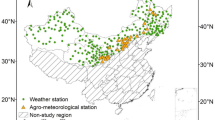Abstract
Maximum yields of potato tubers for growing conditions in the Columbia Basin, Washington, USA were estimated using two methods. The first was based on experimental data from a large number of experiments conducted each year from 1959 through 1973 with Russet Burbank potatoes. The highest yielding plots each year were selected, and boundary analysis was used to determine the relationship between growing season length and maximum yield. Maximum yield was found to be related to growing season length by Y = D - 36 where Y is tuber yield in t/ha and D is days since planting. The second method was based on a model which assumes that dry matter production of a crop is proportional to intercepted radiation. This model has been validated for Scottish growing conditions. The solar radiation conversion efficiency for Russet Burbank potatoes under Columbia Basin conditions was found to be 1.35 g/MJ, using boundary analysis. The model gave better agreement between predicted and measured boundary values than did the simpler model based only on growing season length. Agreement was better, particularly at the end of the growing season when days were shorter and cooler than in the summer. Maximum measured yield was 124 t/ha. The simple model predicted maximum yields around 160 t/ha, while the MW model predicted maximum values around 140 t/ha.
Compendio
Los rendimientos máximos de tubérculos de papa las condiciones de cultivo en la cuenca del Columbia, Washington, USA, fueron estimados utilizando dos métodos. El primero se basaba en datos experimentales obtenidos de un gran número de experimentos conducidos cada año desde 1959 hasta 1973, con papas de la variedad Russet Burbank. Cada año se seleccionaron las parcelas que habían tenido los más altos rendimientos, y se utilizó el análisis de límite para determinar la relación entre la longitud de la temporada de cultivo y el máximo rendimiento. Se encontró que el máximo rendimiento estaba relacionada a la longitud de la temporada de cultivo de acuerdo a Y = D-36, donde Y es el rendimiento en tubérculos en t/ha y D es el número de días a partir de la siembra.
El segundo método se basaba en un modelo que asume que las producción de materia seca de un cultivo es proporcional a la radiación interceptada. Este método ha sido reconocido como válido para las condiciones de cultivo escocesas. La eficiencia de conversión de la radiación solar para las papas Russet Burbank bajo las condiciones de la cuenca del Columbia fue de 1,35 g/MJ, utilizando el análisis de límite. El modelo dió una mayor concordancia entre los valores pronosticados y aquellos obtenidos utilizando límite en comparación con los valores obtenidos utilizando el modelo sencillo basado sólamente en el longitud de la temporada de cultivo. La concordancia fue mayor particularmente al final de la temporada, cuando los días fueron cortos y más fríos que en el verano. El rendimiento máximo medido fue 124 t/ha. El modelo sencillo permitió pronosticar rendimientos máximos cercanos a 160 t/ha, mientras que el modelo MW arrojó un pronóstico con valores próximos a las 140 t/ha.
Similar content being viewed by others
Literature Cited
Bristow, K.L. and G.S. Campbell. 1984. On the relationship between incoming solar radiation and daily maximum and minimum temperature. Agric For Meteorol 31:159–166.
Ingram, K.T. and D.E. McCloud. 1984. Simulation of potato crop growth and development. Crops Sci 24:21–27.
Kunkel, R., N. Holstad and T.S. Russell. 1973. Mineral element content of potato plants and tubers vs. yield. Am Potato J 50:275–282.
MacKerron, D.K.L. and P.D. Waister. 1985. A simple model of potato growth and yield, Part I. Model development and sensitivity analysis. Agric For Meteorol 34:241–252.
Ng, E. and R.S. Loomis. 1984. Simulation of growth and yield of the potato crop. PUDOC, Wageningen, The Netherlands, 147 pp.
Sands, P.J., C. Hacket, and H.A. Nix. 1979. A model of the development and bulking of potatoes (Solanum tuberosum L.) I. Derivation from well-managed field crops. Field Crops Res 2:309–331.
Scott, R.K. and S.J. Wilcockson. 1978. Application of physiological and agronomic principles to the development of the potato industry. In P.M. Harris (ed.). The Potato Crop: Scientific Basis for Improvement. London: Chapman and Hall.
Van der Zaag, D.E. 1984. Reliability and significance of a simple method of estimating the potential yield of the potato crop. Potato Res 27:51–73.
Webb, R.A. 1972. Use of the boundary line in the analysis of biological data. J Hortic Sci 47:309–319.
Author information
Authors and Affiliations
Additional information
Scientific paper no. 7134, Agricultural Research Center, Washington State University, Pullman, WA 99164. Financed, in part, by funds from the Washington Potato Commission.
Rights and permissions
About this article
Cite this article
Kunkel, R., Campbell, G.S. Maximum potential potato yield in the Columbia Basin, USA: Model and measured values. American Potato Journal 64, 355–366 (1987). https://doi.org/10.1007/BF02853597
Accepted:
Issue Date:
DOI: https://doi.org/10.1007/BF02853597




